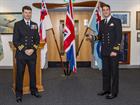NAVAL PILOT LEWIS MAKES HISTORY EARNING WINGS ON NEW TRAINER
The first naval aviator has earned his Wings on the military’s new fast jet trainer.
Lieutenant Lewis Phillips received the proud emblem of a qualified pilot after 12 demanding months at RAF Valley in Anglesey, where he was taught the basics of operating a 21st-Century fast jet in the Texan T1.
First in the classrooms and simulators, and then in the Texan’s cockpit, he’s learned the fundamentals of handling a jet-engine aircraft, including formation flying, low-level navigation and coping with all weather conditions.
Twelve months ago, the 30-year-old from Portsmouth was the first trainee jet pilot to fly solo in a Texan.
And a year on, he’s now the first Fleet Air Arm flier to earn his Wings in the aircraft, the only naval aviator among six pilots who graduated from 72 Squadron at Valley.
The Texan replaced the (very similar looking) Tucano which served fast-jet pilots well for the past 30 years.
But with today’s fully-digital jets and helicopters, the analogue trainer was seen as obsolete and phased out.
Its successor has a fully digitised (aka ‘glass’) cockpit, reaches top speeds of more than 360mph and can climb as high as 31,000ft.
All of which means students must get used to wearing G-suits to counter the effects of gravity on the strains and stresses of flight, an immersion suit in case the Texan has to ditch, wearing an oxygen mask rather than breathing normally.
“The Texan is really nice to fly and a noticeable power increase from previous aircraft I’ve flown – the Tutor and Prefect,” said Lewis.
“Having a ‘glass’ cockpit is also a huge benefit and step change in training, allowing instructors to deliver electronic warfare threats we need to defend against and make a sortie feel a lot more realistic.”
Lewis spent nine years in the Navy as an air traffic control officer, before swapping the control tower for the cockpit.
The long road to becoming a fast-jet pilot begins with learning the basics of flight at Barkston Heath in Lincolnshire in the Grob Tutor, then moves to Valley and the Texan which handles like a jet despite being propeller-driven, then on to jets and finally a conversion course to a front-line fighter.
In Lewis’ case it’s not Hawk then F-35, but an exchange programme with the Americans (part of the Long Lead programme as part of the RN’s return to carrier strike operations).
He’ll get his first jet experience in a T45 Goshawk trainer – the US Navy’s counterpart to the Hawk – before moving on to the F-18 Super Hornet, the mainstay of combat operations on America’s carrier fleet.
"I am honoured to be the first Royal Navy pilot to graduate with Wings on the Texan T1,” Lewis continued.
“It certainly isn't lost on me that I wear the same uniform – and now the same Wings – as all those who came before me.
“I am excited about the career which lies ahead and although receiving my wings indicates the end to my initial training as a pilot, it also indicates the beginning of an even steeper learning curve – a challenge which I look forward to."





